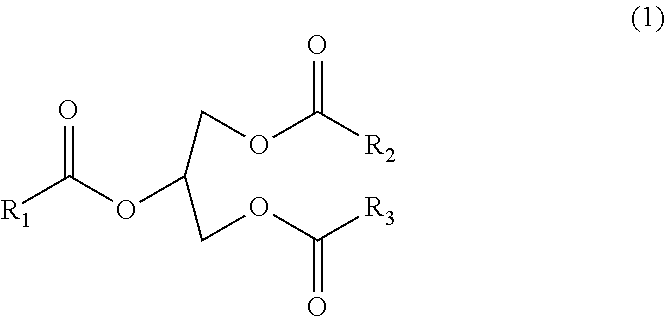Simultaneous Production of Base Oil and Fuel Components from Renewable Feedstock
a technology of fuel components and feedstock, which is applied in the field of hydrocarbon production, can solve the problems of limited use of lube esters, harmful effects on atmosphere and environment, exhaustion of fossil raw materials, etc., and achieves the effects of high energy consumption, reduced production cost, and reduced production cos
- Summary
- Abstract
- Description
- Claims
- Application Information
AI Technical Summary
Benefits of technology
Problems solved by technology
Method used
Image
Examples
example 1
[0104]A mixture of stearic acid and palm oil was subjected to combined ketonisation and hydrotreatment in the presence of sulfidised K2O / TiO2—NiMo dual catalyst system. The catalyst system was prepared by crushing an alumina supported NiMo catalyst and a K2O / TiO2 catalyst and thoroughly mixing the two together. The reaction was carried out using hydrogen to hydrocarbon (H2 / HC) ratio of 500 NI / I and a weight hourly space velocity (WHSV) of 1.0 h−1. Three separate tests (test I, test II and test III) were conducted and the other process conditions and hydrocarbon distribution of the product form is shown in table 1.
TABLE 1Process conditions and product distribution of the various testsTPC11-C23≧C24Test° C.Mpa%*%*I340280.92.1II365279.14.1III3650.6747.6*The rest of the product formed is light hydrocarbon gas and water
[0105]The product obtained in test III was distilled in reduced pressure to two separate fraction and the base oil fraction (>C24) was analysed. The kinematic viscosities o...
example 2
[0107]A mixture of stearic acid (30 wt-%) and palm oil (70 wt-%) was subjected to a combined ketonisation and hydrotreatment process. The process was carried out in the presence of a sulphidized K2O / TiO2—NiMo dual catalyst system prepared as in Example 1. The ratio of K2O / TiO2 to NiMo on alumina support was 50:50 wt-%. The process conditions were as follows[0108]Temperature of 365° C.,[0109]Pressure of 0.6 MPa, H[0110]Hydrogen to hydrocarbon (H2 / HC) ratio of 500 NI / I and[0111]Weight hourly space velocity (WHSV) of 1.0 1 / h.
TABLE 3Product distributionGas + H2OGasolineDieselBase oilC1-4C5-10C11-23≧C2417.80.373.08.7
[0112]The product obtained was analyzed with gas chromatography. The obtained GC chromatogram confirms the formation of linear C33 and C35 paraffins. The GC chromatogram also shows some peaks which were identified as ketones.
[0113]The product obtained was also distillated in reduced pressure to two separate fractions and analyzed. Properties of produced base oil components an...
example 3
[0114]The reaction of example 2 was repeated with a mixture of palm oil fatty acid (30 wt-%) and palm oil (70 wt-%), except for using a pressure of 2 MPa (instead of 0.6 MPa in example 2). Similar product distribution was achieved with the use of palm oil fatty acid (PFAD) instead of pure stearic acid, with only a slight decrease in the base oil yield (5.5%>C24 compared to 7.6% in example 2).
[0115]The product obtained was distilled in reduced pressure to two separate fractions and analyzed. Properties of produced base oil components and properties fuel fraction components are presented in Table 6 and 7.
TABLE 6Base oil component (lube component) from the process,prior to isomerisationENISO3104Viscosity 40° C.mm2 / s23.09ENISO3104Viscosity 80° C.mm2 / s7.928ENISO3104Viscosity 100° C.mm2 / s5.385ASTMD2270VI181ASTMD7346 MPour point° C.>45
TABLE 7Fuel component (diesel, kerosene, naphta) from the process,prior to isomerisationENISO12185Densitykg / m3784.7NM473Cloud point° C.20.6ENISO3104Viscosity...
PUM
| Property | Measurement | Unit |
|---|---|---|
| pressure | aaaaa | aaaaa |
| pressure | aaaaa | aaaaa |
| temperature | aaaaa | aaaaa |
Abstract
Description
Claims
Application Information
 Login to View More
Login to View More - R&D
- Intellectual Property
- Life Sciences
- Materials
- Tech Scout
- Unparalleled Data Quality
- Higher Quality Content
- 60% Fewer Hallucinations
Browse by: Latest US Patents, China's latest patents, Technical Efficacy Thesaurus, Application Domain, Technology Topic, Popular Technical Reports.
© 2025 PatSnap. All rights reserved.Legal|Privacy policy|Modern Slavery Act Transparency Statement|Sitemap|About US| Contact US: help@patsnap.com


